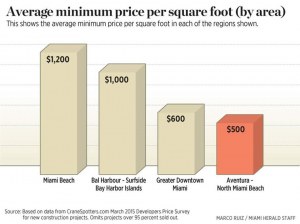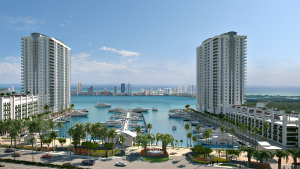As traffic congestion worsens in South Florida, a plan to restore passenger service to the Florida East Coast Railway corridor that dates back to industrialist Henry Flagler’s first train service to Miami in 1896 is generating a buzz in the local real estate development community.
Opportunity-minded investors are closely monitoring a two-tiered process that could ultimately result in regular daily train service from Miami to Orlando with multiple stops in between in various downtowns in Miami-Dade, Broward and Palm Beach counties. To accommodate the proposed new passenger commuter service, plans call for the creation of nearly 30 train stations to be built east of Interstate 95 along the South Florida coast.
The creation of train stations for the planned passenger service is expected to trigger a wide array of indirect investment in the surrounding areas to develop everything from residential towers to retail centers, hotels to office buildings. Under a pair of separate but interconnected plans, All Aboard Florida — an entity that is privately controlled by the owner of the Florida East Coast tracks — wants to launch a high-speed passenger rail service from downtown Miami to Orlando with stops in the downtowns of Fort Lauderdale and West Palm Beach. This service is scheduled to begin by 2016.
Just this month, All Aboard Florida issued $405 million of debt to help finance the creation of the high-speed rail service that is expected to cost at least $2 billion. Complementing the All Aboard Florida private-sector initiative, the South Florida Regional Transportation Authority — a public entity that oversees the Tri-Rail passenger service on tracks west of Interstate 95 — plans to introduce a new commuter line that is to travel on the Florida East Coast line on the east side of Interstate 95 with stops in various downtowns from Miami to West Palm Beach.
Under the Tri-Rail plan, Miami-Dade County would have eight stations stretching from Aventura to the Miami Design District to a newly proposed Grand Central Station to be built in downtown Miami. Plans call for the east of Interstate 95 commuter service — dubbed the TriRail Coastal Link — to be “implemented” within seven years for a launch in or before the year 2020, according to the organization’s website.
Ironically, the same train tracks that have historically meant lower prices and constant complaints about noise and traffic delays from nearby residents are expected to trigger a wave of new residential developments for individuals seeking easy access to planned passenger rail service.
Anyone who has ever relied on public transportation knows that train service is much more predictable than that of buses. Many commuters in cities around the world generally attempt to live and work close to train stations to improve the efficiency of using public transportation. As a result of this phenomenon, the introduction of passenger rail service in Miami-Dade County has the potential to stimulate real estate development in areas that are far removed from the water.
It is not surprising that developers who focus on the South Florida mainland have typically tried to build condo towers on sites that front Biscayne Bay or the Intracoastal Waterway. If waterfront land is not available at acceptable prices, the next best alternatives are usually development sites in popular neighborhoods such as Midtown Miami or on iconic streets such as Brickell Avenue.
Generally, the interest level in land near the railroad tracks — which are west of Biscayne Boulevard and east of Interstate 95 — is not the first choice for developers or buyers in South Florida, especially in Miami-Dade County. For example, fewer than 385 condos between west of Biscayne Boulevard and east of Interstate 95 from Flagler Street in downtown Miami north to Aventura were sold, at an average price of about $187 per square foot, between January and May of this year, according to the Southeast Florida MLXchange. By comparison, nearly 1,025 condo units east of Biscayne Boulevard from Flagler Street in downtown Miami north to Aventura were sold, at an average price of $250 per square foot, during the first five months of the year.
Some quick arithmetic suggests condo units east of Biscayne Boulevard traded at an average premium of 34 percent over the units on the west side of the street, according to the data. As for the supply of available condos, about 800 units are currently on the resale market west of Biscayne Boulevard from downtown Miami to Aventura.
Based on the 2014 sales pace of about 77 transactions monthly, there is more than 10 months of available inventory on the market west of Biscayne Boulevard, according to the data. The condo market east of Biscayne Boulevard from downtown Miami to Aventura has nearly 1,800 units available for resale. Despite having more units up for resale than the area west of Biscayne Boulevard, the condo market east of Biscayne Boulevard has less than nine months of supply available, according to the data.
For the rental market, there is less of a difference between east and west of Biscayne Boulevard in Miami-Dade County from downtown Miami north to Aventura when it comes to price and transactions. Tenants leased more than 1,025 residential properties west of Biscayne Boulevard at an average price of $1.63 per square foot monthly between January and May of this year, according to the data.
For the same five-month period, tenants leased nearly 1,200 residential properties east of Biscayne Boulevard at an average price of nearly $1.62 per square foot month. Currently, about two months of rental-property supply are available for lease west and east of Biscayne Boulevard, according to the data.
Given the market trends, developers could become more open to the idea of building residential towers in the area located west of Biscayne Boulevard and east of Interstate 95 especially since land costs are generally cheaper and rents are comparable to those rates being achieved on the east side of Biscayne Boulevard.
The unanswered question going forward is whether developers and residents will ultimately embrace a lifestyle in South Florida that revolves more around public transportation than the current dependence on cars. If this were to happen as the government planners are hoping, the future of real estate development in Miami-Dade County could increasingly focus on the land west of Biscayne Boulevard in the coming years.
Source: Miami Herald






